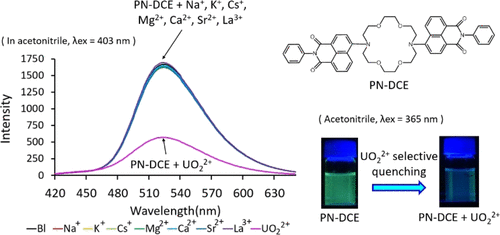当前位置:
X-MOL 学术
›
ACS Earth Space Chem.
›
论文详情
Our official English website, www.x-mol.net, welcomes your feedback! (Note: you will need to create a separate account there.)
Studies on Coordination and Fluorescence Behaviors of a Novel Uranyl Ion-Selective Chemosensor Bearing Diaza 18-Crown-6 Ether and Naphthalimide Moieties
ACS Earth and Space Chemistry ( IF 3.4 ) Pub Date : 2020-12-08 , DOI: 10.1021/acsearthspacechem.0c00184 Min Seok Kim 1 , Takehiko Tsukahara 1
ACS Earth and Space Chemistry ( IF 3.4 ) Pub Date : 2020-12-08 , DOI: 10.1021/acsearthspacechem.0c00184 Min Seok Kim 1 , Takehiko Tsukahara 1
Affiliation

|
To avoid environmental and biological impacts linked to uranium-contaminating solutions, the development of sensitive and selective uranium detection techniques for solutions has become a critical issue. Although various kinds of detection methodologies have been developed, they are still not totally satisfactory in terms of simplicity, efficiency, and versatility. In this work, a novel chemosensor bearing a diaza-18-crown-6 ether and two naphthalimides (PN-DCE) was synthesized for simple, selective, rapid, and cost-effective detection of uranyl ions (UO22+) and characterized by 1H-, 13C-NMR, FT-IR, ESI-TOF-MS, and elemental analysis. Effects of various metal ions (Na+, K+, Cs+, Mg2+, Ca2+, Sr2+, La3+, and UO22+) on the 1H-NMR chemical shifts of PN-DCE were examined, and selective complexation of UO22+ with PN-DCE was verified. Moreover, the stoichiometry of the UO22+/PN-DCE complex was elucidated from the correlation between UO22+ concentration and the peak area ratios of the 1H-NMR spectra of PN-DCE, indicating the formation of 1:1 and 2:1 complexes depending on the concentration ratios of UO22+ and PN-DCE ([UO22+]/[PN-DCE]). Furthermore, visual and fluorescence spectroscopic methods showed that drastic fluorescence quenching of PN-DCE is induced by adding UO22+ and not other metal ions. From a combination of quenching percentages estimated from fluorometric titration experiments and Stern–Volmer analysis, the detection limit of PN-DCE for UO22+ was successfully determined to be 4.13 μM, which is almost comparable to the maximum permissible concentration of uranium in wastewater discharged from facilities related to the utilization of nuclear energy. Based on these results, we conclude that the developed PN-DCE would act as a sensing material for UO22+ in waste solutions.
中文翻译:

新型带有Diaza 18-Crown-6醚和萘二甲酰亚胺基的铀酰离子选择性化学传感器的配位和荧光行为研究
为了避免与铀污染解决方案相关的环境和生物影响,开发用于解决方案的灵敏和选择性的铀检测技术已成为一个关键问题。尽管已经开发了各种检测方法,但是就简单性,效率和多功能性而言,它们仍不完全令人满意。在这项工作中,合成了带有二氮杂18冠6醚和两个萘二甲酰亚胺(PN-DCE)的新型化学传感器,用于简单,选择性,快速且经济高效地检测铀酰离子(UO 2 2+)并进行了表征由1 H-,13 C-NMR,FT-IR,ESI-TOF-MS和元素分析。各种金属离子(Na +,K +,Cs +,Mg 2 +,Ca 2 +,Sr 2 +,La 3+和UO 2 2+)在PN-DCE的1 H-NMR化学位移上进行了研究,并选择性地将UO 2 2+与PN-DCE络合已验证。此外,从UO 2 2+浓度与PN-DCE的1 H-NMR光谱的峰面积比之间的相关性阐明了UO 2 2+ / PN-DCE配合物的化学计量,表明形成了1:1和2:1配合物,具体取决于UO 2 2+和PN-DCE([UO 2 2+] / [PN-DCE])。此外,视觉和荧光光谱法表明,PN-DCE的剧烈荧光猝灭是通过添加UO 2 2+而不是其他金属离子诱导的。通过荧光滴定实验和斯特恩-沃尔默分析估计的猝灭百分比的组合,成功地确定了PN-DCE对UO 2 2+的检出限为4.13μM ,几乎与废水中铀的最大允许浓度相当。从与利用核能有关的设施中排放出来的。根据这些结果,我们得出结论,开发的PN-DCE可以作为废物溶液中UO 2 2+的传感材料。
更新日期:2020-12-17
中文翻译:

新型带有Diaza 18-Crown-6醚和萘二甲酰亚胺基的铀酰离子选择性化学传感器的配位和荧光行为研究
为了避免与铀污染解决方案相关的环境和生物影响,开发用于解决方案的灵敏和选择性的铀检测技术已成为一个关键问题。尽管已经开发了各种检测方法,但是就简单性,效率和多功能性而言,它们仍不完全令人满意。在这项工作中,合成了带有二氮杂18冠6醚和两个萘二甲酰亚胺(PN-DCE)的新型化学传感器,用于简单,选择性,快速且经济高效地检测铀酰离子(UO 2 2+)并进行了表征由1 H-,13 C-NMR,FT-IR,ESI-TOF-MS和元素分析。各种金属离子(Na +,K +,Cs +,Mg 2 +,Ca 2 +,Sr 2 +,La 3+和UO 2 2+)在PN-DCE的1 H-NMR化学位移上进行了研究,并选择性地将UO 2 2+与PN-DCE络合已验证。此外,从UO 2 2+浓度与PN-DCE的1 H-NMR光谱的峰面积比之间的相关性阐明了UO 2 2+ / PN-DCE配合物的化学计量,表明形成了1:1和2:1配合物,具体取决于UO 2 2+和PN-DCE([UO 2 2+] / [PN-DCE])。此外,视觉和荧光光谱法表明,PN-DCE的剧烈荧光猝灭是通过添加UO 2 2+而不是其他金属离子诱导的。通过荧光滴定实验和斯特恩-沃尔默分析估计的猝灭百分比的组合,成功地确定了PN-DCE对UO 2 2+的检出限为4.13μM ,几乎与废水中铀的最大允许浓度相当。从与利用核能有关的设施中排放出来的。根据这些结果,我们得出结论,开发的PN-DCE可以作为废物溶液中UO 2 2+的传感材料。



























 京公网安备 11010802027423号
京公网安备 11010802027423号